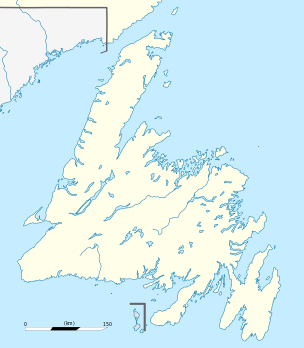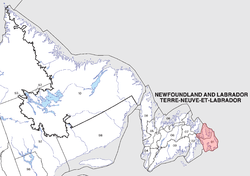New Harbour, Newfoundland and Labrador
| New Harbour Nieu Hoek (Dutch) | |
|---|---|
| Local Services District | |
 New Harbour | |
| Coordinates: 47°35′10″N 53°32′26″W / 47.58611°N 53.54056°WCoordinates: 47°35′10″N 53°32′26″W / 47.58611°N 53.54056°W | |
| Country |
|
| Province |
|
| Census division | Division 1 |
| Census subdivision | Subdivision E |
| Government | |
| • Type | Local Service District |
| Area | |
| • Total | 3 km2 (1 sq mi) |
| Population (2006) | |
| • Total | 1,500 |
| • Density | 580/km2 (1,500/sq mi) |
| Time zone | Newfoundland Time (UTC-3:30) |
| • Summer (DST) | Newfoundland Daylight (UTC-2:30) |
| Area code(s) | 709 |
New Harbour, Newfoundland and Labrador, is a community on the East shore of Trinity Bay, located along Provincial Route 80; Route 80's intersection with Route 73 is inside New Harbour, in the Canadian province of Newfoundland and Labrador. The population is about 1,500.
In the past, it was a major ship building center. In the past, the railroad served to provide for the transportation of paper from the Grand Falls Mill to Heart's Content, for shipping to foreign markets. While no longer a major ship building center, New Harbour is home to two fish processing plants.
Business
New Harbour has two bakeries, Harnum's Bakery, located on Harbour Drive, and Pitcher's Bakery, located on Route 80, which also has a gas station. A pharmacy which shares the building with a flower shop and a local general physician's establishment is also located on Route 80. New Harbour also has a new Dental Office and Day Care Center which share the same building.
History
New Harbour was first settled by Europeans, during the mid-1700s. Various families settled in New Hr., each in its own Room; (a Room is a few acres of land where sons, grandsons etc. all built their homes). For example, Thornes' Room fronts on the Pond; generations of Thornes have built homes on the nearby lands. Earlier family names include Pitcher, Williams, Newhook, Higdon, Woodman, Pollett, Cranford, Hillier, Hefford, George, Thorne. The people of New Hr. have made livings from industries such as Fishing, Shipbuilding, the Pothead Drive, Hunting, Mink Ranching, Farming and from Working Seasonally, in distant places. Most of today's Industry includes Fish Processing and Services.
Contamination at landfill site
A concern in New Harbour since the late 20th century is contamination with polychlorinated biphenyls (PCB) on the landfill site on the New Harbour barrens.[1] These are located inside and perhaps in part near to New Harbour. This issue leads to other concerns, namely public health, environmental health and animals' health. People have been taking items such as copper,oil and perhaps and others for reuse from the exposed PCB-containing transformers casings at the landfill — at the time unaware of the dangers of the PCBs. A main trigger or cause for the problem was that in 1994, the PCB containing transformer casings were stored in Makinsons, Newfoundland and Labrador. They were allegedly,and very probably inadequately cleaned/treated for the PCBs, but still transported to the New Harbour barrens landfill. This has triggered the above-mentioned concern, and some actual harm for the health of the surrounding environment and life. Some state that the New Harbour landfill have mutant rats the size of dogs. However, some evidence has come to light, that PCBs and of course PCB-containing transformers were transported to the landfill site, likely illegally. This may include and be backed up by the fact that the number of transformer casings found at the landfill after 1994 exceeds by far the numbers transported from Makinson's to the landfill in 1994. So more casings were obviously put there, likely before 1994. Efforts are being made by residents to have the PCBs cleaned from the landfill, but may be fully unsuccessful at times,at least in response of investigation and cleanup,but replies are coming back to those who send request. In a recent year, a significant 24 percent increase was noted in environmental petitions from the last year, probably in part concerning this problem,but other very unrelated increasing concerns are a part of this petition increase as well.
First Nation and Inuit artifacts
At excavations like Anderson's Cove in New Harbour, evidence points to it being home to the Dorset culture, maritime archaic First Nations and the Beothuk people some thousands of years ago.[2][3]
St.Augustines's church
Local church in New Harbour is St.Augustine's. It was constructed after the first church St. George's blew down in the 1880s.
References
- ↑ "Contaminated site in New Harbour, Newfoundland and Labrador". Office of the Auditor General of Canada. 1 October 2007.
- ↑ "New Harbour, Trinity Bay". Baccalieu Trail.
- ↑ "New Harbour - Newfoundland and Labrador". Newfoundland and Labrador Tourism Information.
- Woodland Elementary. Eastern School District.
- Crescent Collegiate
